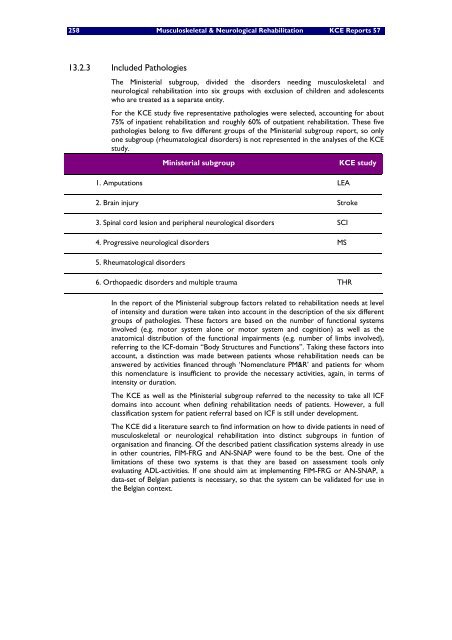The report is available in English with a French summary - KCE
The report is available in English with a French summary - KCE
The report is available in English with a French summary - KCE
Create successful ePaper yourself
Turn your PDF publications into a flip-book with our unique Google optimized e-Paper software.
258 Musculoskeletal & Neurological Rehabilitation <strong>KCE</strong> Reports 57<br />
13.2.3 Included Pathologies<br />
<strong>The</strong> M<strong>in</strong><strong>is</strong>terial subgroup, divided the d<strong>is</strong>orders need<strong>in</strong>g musculoskeletal and<br />
neurological rehabilitation <strong>in</strong>to six groups <strong>with</strong> exclusion of children and adolescents<br />
who are treated as a separate entity.<br />
For the <strong>KCE</strong> study five representative pathologies were selected, account<strong>in</strong>g for about<br />
75% of <strong>in</strong>patient rehabilitation and roughly 60% of outpatient rehabilitation. <strong>The</strong>se five<br />
pathologies belong to five different groups of the M<strong>in</strong><strong>is</strong>terial subgroup <strong>report</strong>, so only<br />
one subgroup (rheumatological d<strong>is</strong>orders) <strong>is</strong> not represented <strong>in</strong> the analyses of the <strong>KCE</strong><br />
study.<br />
M<strong>in</strong><strong>is</strong>terial subgroup <strong>KCE</strong> study<br />
1. Amputations LEA<br />
2. Bra<strong>in</strong> <strong>in</strong>jury Stroke<br />
3. Sp<strong>in</strong>al cord lesion and peripheral neurological d<strong>is</strong>orders SCI<br />
4. Progressive neurological d<strong>is</strong>orders MS<br />
5. Rheumatological d<strong>is</strong>orders<br />
6. Orthopaedic d<strong>is</strong>orders and multiple trauma THR<br />
In the <strong>report</strong> of the M<strong>in</strong><strong>is</strong>terial subgroup factors related to rehabilitation needs at level<br />
of <strong>in</strong>tensity and duration were taken <strong>in</strong>to account <strong>in</strong> the description of the six different<br />
groups of pathologies. <strong>The</strong>se factors are based on the number of functional systems<br />
<strong>in</strong>volved (e.g. motor system alone or motor system and cognition) as well as the<br />
anatomical d<strong>is</strong>tribution of the functional impairments (e.g. number of limbs <strong>in</strong>volved),<br />
referr<strong>in</strong>g to the ICF-doma<strong>in</strong> “Body Structures and Functions”. Tak<strong>in</strong>g these factors <strong>in</strong>to<br />
account, a d<strong>is</strong>t<strong>in</strong>ction was made between patients whose rehabilitation needs can be<br />
answered by activities f<strong>in</strong>anced through ‘Nomenclature PM&R’ and patients for whom<br />
th<strong>is</strong> nomenclature <strong>is</strong> <strong>in</strong>sufficient to provide the necessary activities, aga<strong>in</strong>, <strong>in</strong> terms of<br />
<strong>in</strong>tensity or duration.<br />
<strong>The</strong> <strong>KCE</strong> as well as the M<strong>in</strong><strong>is</strong>terial subgroup referred to the necessity to take all ICF<br />
doma<strong>in</strong>s <strong>in</strong>to account when def<strong>in</strong><strong>in</strong>g rehabilitation needs of patients. However, a full<br />
classification system for patient referral based on ICF <strong>is</strong> still under development.<br />
<strong>The</strong> <strong>KCE</strong> did a literature search to f<strong>in</strong>d <strong>in</strong>formation on how to divide patients <strong>in</strong> need of<br />
musculoskeletal or neurological rehabilitation <strong>in</strong>to d<strong>is</strong>t<strong>in</strong>ct subgroups <strong>in</strong> funtion of<br />
organ<strong>is</strong>ation and f<strong>in</strong>anc<strong>in</strong>g. Of the described patient classification systems already <strong>in</strong> use<br />
<strong>in</strong> other countries, FIM-FRG and AN-SNAP were found to be the best. One of the<br />
limitations of these two systems <strong>is</strong> that they are based on assessment tools only<br />
evaluat<strong>in</strong>g ADL-activities. If one should aim at implement<strong>in</strong>g FIM-FRG or AN-SNAP, a<br />
data-set of Belgian patients <strong>is</strong> necessary, so that the system can be validated for use <strong>in</strong><br />
the Belgian context.

















